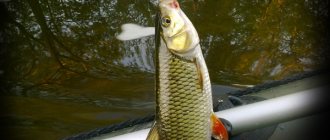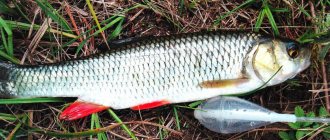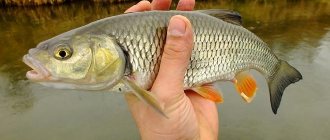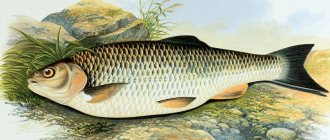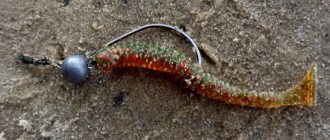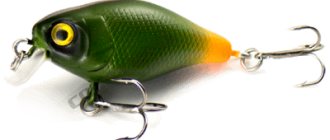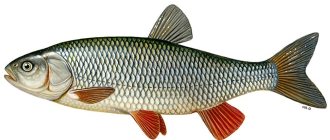Our time is characterized by the rapid pace of development of the fishing industry. As soon as one person comes up with a new type of bait, and another catches a fish with it, and proves its superiority over other types of bait, the opinion about the miracle bait spreads among fishermen at the speed of light.
Meanwhile, fishing companies are adopting a new invention and launching mass production of a product that interests everyone.
This is exactly how the “silicon revolution” happened. Now it's time for microoscillators.
Small oscillating spoons have been known for a long time. They were produced in the USA, Canada, and Europe. The circle of their admirers was very limited. Spinning anglers used them when fishing for trout, grayling, perch, and “white” predators along with spinners and wobblers, and priority remained with the latter types of bait.
The growth in popularity of micro-spinners is due to two factors : the general passion for such a direction of spinning fishing as ultralight, and the rapid development of recreational fishing, which means fishing for rainbow trout in paid reservoirs or area fishing. Well, the country that instantly took the lead in the production of micro-oscillators was Japan.
RODIO CRAFT BLINDE FLANKER
0.5g.
20mm This is my discovery 16g. Truly a pearl in a sea of slag. Despite its ultra-light weight and small size, the spinner can provoke a bite even from fish that won’t even look at other baits. Its strong point is the surface layer, the so-called glider, when you drive a spinner almost on the surface of the water surface and microwaves radiate from it in different directions, such as from a moth or a stupid midge that has landed in the water to feed hungry fish. I’ll tell you a secret that during evening twilight any fish that comes to the surface of the water to feed for insects grabs it indiscriminately. But this crumb works not only in the surface layers, it is also characterized by classic wiring in all horizons, both in standing reservoirs and on the current.
I had the opportunity to catch a variety of chubs with this spinner from outright small fry to 700g, gudgeon, perch, miniature pikes, platy, nanopike, rudd and bleak. All that remains for me to add is that if you know where there are a lot of small (and other) chub that refuse to peck at other baits, then my advice to you is to boldly take it in this particular color and the result will not keep you waiting long.
Micro-oscillators cling less to grass and snags
A single hook also has obvious advantages compared to a tee. When wiring, micro-oscillators for the most part go with the curved side down, and the tip of the hook is directed upward, which noticeably reduces the number of snags on snags or bottom grass. In relatively clean areas, the lure can even work along the bottom, using stepped wiring.
Despite the fact that the predator, apparently, is more focused on the vibrations that the spinner creates when moving, its color also often affects the bite. Like all baits produced by Japanese companies, the color range of micro-oscillators is extremely wide. At the same time, reputable companies offer such a rich range not because they attract consumers. All of their colors work, but each one turned out to be more catchy in some specific criteria. The selection of bait colors is a very personal matter.
Actually, I usually follow the usual scheme: if the water is cloudy, I prefer colorful colors, including acidic ones, and if it’s transparent, I try completely dark baits with some bright dot or stripe. However, most often the best results are given by “gold” or “silver”. The selection between them depends on the illumination: in bright sunshine, “gold” is superior; in dim weather, “silver” is superior.
Naturally, when choosing a color, it is good to take into account the type of predator that is to be caught. Thus, pike and perch generally choose bright baits with some kind of “finishing” in the form of contrasting stripes or spots, while asp, and often chub, are “led” by light-colored spinners with one bright dot. As you know, almost none of the most successful baits will catch without proper wiring. When fishing in still water, this is usually either a uniform retrieve, or a stepped retrieve, or a combination of both. A very big advantage of these spinners, as I already said, is the ability to operate at the lowest speed of the retrieve. But no less important is that they hold the horizon very well, so you are constantly more or less oriented at what depth the bait is located.
To do this, it is necessary, of course, to know how quickly it is sinking. According to my measurements, a micro-spoon weighing 3 g per second descends 20–30 cm, depending on its shape. If the depth at the fishing spot is, for example, a meter, then after casting I wait a two-second pause for the spoon to lower, after which I start retrieving, holding the rod at an angle of 45 degrees. In this case, the bait goes approximately 30–40 cm above the bottom. Naturally, the reliability of all these estimates is not high, but the main thing is that it is enough to catch fish. Since the spinners are perfectly balanced, you can change the fishing horizon by simply raising or lowering the tip of the rod slightly, without changing the fishing speed.
Ivyline acti
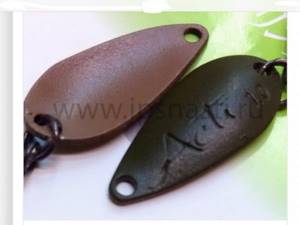
Practice has shown that Akti is best suited for fishing in diverse rivers with not too fast flows. I have a very interesting incident and pleasant memories with this lure associated with the discovery after the spawning ban. On one of the beautiful rivers of the Tambov region. That day I was fishing from a boat, a variety of fish were biting, I caught bee-eater, perch, rudd, chub on various baits, but the most pleasant bonus was an asp a little more than half a kilo. Despite its small size, the fish put up a very serious fight when fishing, giving me a lot of adrenaline and an unforgettable moment of joy. And the bite occurred under the following circumstances: while swimming a long roll (at least 300 meters), I first put on an acti before the roll, as it turned out, not in vain. In the middle of the roll, a twig from a piece of driftwood stuck out of the water on the surface, which in my opinion looked very promising. I anchored the boat opposite this snag, cast a little higher, let the spinner go a little deeper, and begin retrieving it towards the branch. Before the spinner had time to reach the branch, the fry, in the direction of movement towards the action, began to jump in different directions, like schools of mullet from a dolphin (only small ones). Suddenly a powerful bite occurs, the spinning rod bent under the weight and resistance of the beautiful fish, and the clutch was pleasantly pleasing to the ear. Although the trophy turned out to be not great, at that moment for a split moment it seemed to me the opposite. Yveline acti rightfully made it into this top - quite deservedly.
ANTEM AREA SPOON DOHNA
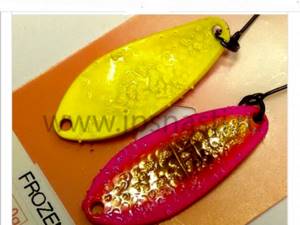
For a long time I couldn’t understand these lures, but now I’ve tried them and will never give them up. These lures are rightfully one of the best that have been developed for trout sport fishing. I use these spoons only on fishing grounds and only for trout, so to speak for their intended purpose. They are produced in weights of 0.8g, 1g, 1.5g, 1.7g, 2.0g, 2.5g, 3.0g and in a large number of colors, in sizes 21mm, 22mm, 25mm, 27mm, 28mm, 32mm. These are, perhaps, the only lures that can cover everything that is necessary to seduce both active and passive trout.
Roma Barinov opened my eyes to this spinner. Once at a competition he handed me this little one, and as a result that day, out of 5 fish caught, she brought me two. These spinners do not get lost on fast retrieves; the action is correct, sweeping from side to side, almost under the very surface of the water surface. This type of wiring is applicable when the trout is freshly launched and stays near the surface. In late autumn before the freeze-up and early spring, when the trout stays near the bottom, you can lead the bottom on the slowest retrieves, literally scratching along the bottom and believe me, in this case you will collect all the trout that are at least a little active.
What are microoscillators
What is the difference from other baits
First of all, the main property of microoscillators is their specialization. Almost all micro-oscillators existing today are designed for catching rainbow trout on “platforms” . Another thing is that in our country, area phishing has not yet become as widespread as in developed countries, and in addition to rainbow trout, in our reservoirs you can catch a wide variety of fish using micro-oscillators, and completely free of charge.
We can say that what distinguishes micro-oscillators from other lures is that for many models there are several modifications that differ in length, weight, thickness of the metal from which they are made, not to mention the color variety. Most micro spinners are equipped with a single hook without a barb, although some companies have launched spinners with a single hook for the Japanese market and a tee for the European and American markets.
Body Shape
All currently produced microoscillators can be divided into three groups:
- narrow, elongated in the shape of a willow leaf;
- narrow, elongated with slight bends;
- wide with significant body curves.
It is rightly believed that the narrower the body shape of the spinner, the more suitable it is for fishing in the current .
Dimensions and specifications
It is quite difficult to give an unambiguous concept to the term “microoscillator”. It is clear that this refers to a small-sized oscillating spoon with all the properties inherent in this class of bait. However, opinions differ regarding its size and weight.
Perhaps it is worth limiting the maximum length of the micro-oscillator to five centimeters, although the vast majority of these baits fit into the range from 15 to 30 mm . The weight of micro-spinners ranges from 0.6 to 5 grams , but the most commonly used baits weigh from 1 to 3 grams .
Micro-oscillators are made from non-ferrous metals and alloys. Spoons differ from each other not only in length and width, but also in thickness.
How to choose
Before voicing recommendations on what fish should be caught with micro-oscillators and what spinners are best to use, we should briefly dwell on the question of where to fish with these baits and the gear that is necessary for such fishing.
As already mentioned, the main object of fishing with micro-spinners, at least in the understanding of their manufacturers, is rainbow trout. They catch it in reservoirs specially designated for this purpose, where the angler is provided with all the conditions for comfortable fishing: the absence of vegetation that interferes with fishing, special bridges.
Many “pay zones” provide fishing enthusiasts with the necessary gear and accessories.
Spinning fishermen who practice area phishing have the opportunity to prolong the pleasure of catching fish, since the most delicate gear is used for catching iris on “platforms”. Usually these are slow-action ultralight spinning rods, thin cords with a breaking load of 2-3 kg.
In contrast, fishermen aimed at catching indigenous inhabitants of water bodies use gear of a different class. Catching fish on the current is called stream phishing . Even moving the bait against the current itself places significant stress on the tackle, not to mention fishing for prey. Therefore, the spinning rod should not bend from the handle, i.e. his system is approaching fast.
The cord used is thin, but not so thin that it breaks at the slightest jerk of the fish. In addition, on rivers, no one is safe from forced fishing in an environment of aquatic vegetation growing everywhere, snags and stones at the bottom. The same can be said about fishing in stagnant, unimproved reservoirs.
The choice of micro-oscillator is dictated by the fishing conditions and the type of fish that the spinning angler intends to hunt. Since almost all micro spinners produced today should provide effective fishing for rainbow trout, it makes no sense to talk about which one is more suitable for catching this fish. In principle, they are all catchers; the choice depends on the preferences of the “iris” in a particular body of water, on the season, on the weather and on many other factors.
For fish that are the original inhabitants of our waters, Russian fishermen have already developed some general rules regarding the choice of spoons. You can catch almost any fish using micro-spinners , but some species are objects of targeted hunting.
Chub
This big-faced inhabitant of our reservoirs is extremely partial to microoscillators. Since it lives exclusively in rivers, elongated spinners are mainly used, since their play is not disrupted by the current. In addition, you can fish with ultra-light spoons, which should be carried just below the surface of the water. It is believed that they imitate some kind of insect.
Asp
Micro-oscillators have proven their effectiveness in catching this fast-moving predator. The spinners used are quite large in size for this class of bait and have a significant (up to 5 grams) weight.
Ide
Ide is also very successfully caught on micro-spinners. Since ide can be caught in both flowing and stagnant bodies of water, the size, weight and shape of the spoon should be selected in accordance with the fishing conditions.
Perch
Perch bites on almost all types of micro-oscillators. The choice of a specific model is determined by the fishing conditions, the size of the prey and the degree of its activity.
Pike
It is, of course, better to catch pike with normal rather than “micro” size baits. However, there are spinning anglers who will not exchange ultralight for any other fishing method, and pike is found in their catches quite often. In addition, there are periods of extremely low predator activity, and at such times a micro-oscillator can significantly increase the chances of catching fish.
In addition to the listed fish species, trout, grayling, bleak, saberfish and rudd are purposefully caught using micro-spinners, and a variety of inhabitants of our waters can be caught in the bycatch.
ROB CHIBI-GILL
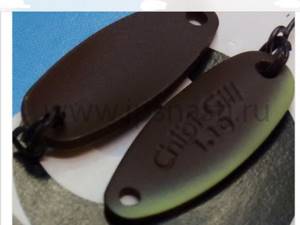
ROB CHIBI-GILL can be compared with iveline acti in that the spinner is a streaming spinner and has a decent weight despite its small size. The game is stable, the main fishing horizon is from the bottom. When performing bottom castings for demolition, this is when you stand on the bank of a medium-fast river, cast upstream diagonally to the shore, let the spinner swirl all the way to the bottom, the spinner plays in the stream almost by itself, you just take out the slack of the fishing line - you need to achieve the spoon was about 10cm from the bottom. Here you are standing, retrieving, the spinner reaches the edge - at this moment you should be on alert in anticipation of a bite. I caught a lot of fish this way, and of course not only with this lure. This method also has some disadvantages: without knowing the underwater conditions (snags, rocks, thickets of grass), you can lose your favorite bait. But whoever does not take risks is without fish.
Features of summer and autumn chub fishing with spoons
A typical example of summer fishing, when after 8 hours the chub bite is over, and the fish takes shady places near trees and feeds on insects. Catching chub at such moments with surface baits such as cranks and wobblers is not particularly successful. You can only try poppers that clap like New Year's crackers.
In summer, it is best to catch chub using spoons near the algae. It often happens that a spinner, going just above the grass, becomes the object of hunting for a stagnant chub, languishing from idleness. This is why a single hook is preferred. It passes through thickets of grass and even some snags with relative ease. When fishing in such areas, it is sometimes better to use non-hook baits.
Another promising area for summer chub fishing with spoons is beaches with sandy shores. In such places the bottom drops evenly and is shallow along the shore. In such places, light baits that enter the water very quietly work better. The light oscillator sinks smoothly and the attack follows sharp and decisive.
You need to understand that the chub is a fish that counts on gifts from the sky. Berries, insects and other food that fall into the water often do not reach the bottom and end up in the mouth of this fish. Therefore, a vibrator is selected that slowly falls and even hangs a little in the water. Models with a wide petal have similar properties.
In the autumn, when fishing for chub, some spinners set a minimum goal - to get away from zero. And in vain. In autumn, the water becomes clear, and the food supply decreases every day. Simply put, the chub has less food. Mulberries or cherries no longer fall from the sky for him. There are already few beetles and no butterflies.
The chub can also stay in more distant areas. The fisherman’s task is to dress in camouflage clothing and quietly approach the place and hide behind bushes or other vegetation. The noisy barbecue and vodka format of fishing will not work here, and you will not get away from zero. It is after such fishing that you can hear from some that “now the chub doesn’t take it anymore.” It is extremely important to use models that demonstrate measured and not very active play during wiring.
We invite you to familiarize yourself with: Feeder tackle: rod, reel, feeders, fishing line and hooks
ROB GILLGAMESH
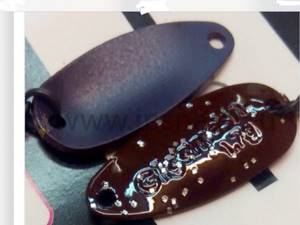
Very smooth, for its low weight, flies beyond the horizon. It appeared in my arsenal by accident - it was given to me by a friend, saying it was lying idle. I caught it in the spring, on trout, and when the freckled trout was pretty much pinched and there were almost no bites on other baits. Later in the summer it came in handy on the chub river. It’s impossible to say that the chub rushed at her, but there were bites, and with them the capture of the big one. It’s hard to say why exactly, but I’m interested in this spinner; I’ve bought a few more colors for myself for the upcoming season to try out.
RODIO CRAFT JEKYLL JR

The oblong shape of this miniature spinner resembles half a sunflower seed shell. And the miniature weight allows you to open up new horizons of application for the fisherman, as he was convinced of from his personal experience when catching non-standard fish for spinning, namely rudd. The fishing was carried out in the format of float fishing. I noticed the windows in the vegetation and decided to throw bait there. Someone attacked the bait, but to no avail. By simply sorting out the baits, it was the Jekyll’s turn. But apparently the rudd in this window has already lost interest in the baits or is simply wary. I swim across carefully, trying not to create unnecessary noise with the oars, to the next window at a comfortable casting distance. I make an accurate cast and on the first even retrieve there is a confident bite and the fish flutters pleasantly on the bait. It should be noted that rudd offers decent resistance - no worse than perch, and in terms of spectacular bites it outshines many other fish species. On this day, I consolidated and trained my acquired skills in catching rudd, and Jekyll helped me succeed in this. In the future, I plan to write a separate article on such exciting and entertaining fishing as targeted fishing for rudd using a spinning rod.
NORIES MASUKUROTO WEEPER

25mm. This spinner sparked my love for micro-oscillators. And to be more precise, from its exact copy from Laika John - a model called Ima. Several years ago I dreamed of learning how to catch chub with a spinning rod, but I never succeeded. It seemed like I did everything correctly and the tackle and bait corresponded to all the classic chub patterns. Having read and watched enough films, I tried to fish with wobblers and this was my main mistake, since the result was almost zero, if I managed to see at least one bite during fishing, then I thought that the fishing was not in vain. The next winter, I decided to radically change my approach to chub fishing, and for the season I collected a dozen micro-oscillators and several spinners (which I completely abandoned over time, I don’t like it when the line gets twisted). As already written above, the first catchable spinner was Ima from Laika John, in the “seed” color. It began to be possible to catch chubs consistently, and the performance reached 10 fish per day. Now, of course, more catchy lures have appeared in my arsenal, and I have gained experience. But it all started with her.
Thanks to its developer, the Japanese Rikiya Kimura, for this weeper, because without the original there would be no copy. A couple of years ago, the 2.1g Viper was discontinued. I hope that the Nories company will change its decision, the spinner is working and has the right to life, taking its rightful place in the wallet with baits.
Places for catching chub on spoons
It is convenient to catch chub in narrow rivers. You can quickly find promising points and zones and fish them tightly. Among such places, first of all, we note riffles that turn into a pool, shady areas near trees hanging over the water, coastal dumps where the current intensifies, places behind large stones and fallen trees.
Note that there are more than enough such places on fast-flowing rivers. But the beauty of catching chub with spinning baits is that there is no point in staying in one place for more than 10 minutes. The first retrieve is the most promising and is the one most often taken by the chub. After an unsuccessful attempt to catch a handsome redfin on a wobbler, we make the next trip with a small jig. Sometimes he takes better on small bait when he is not hungry.
Sometimes a chub is caught at those moments when we catch an asp. In principle, places in the area of dumps and rifts and with reverse flow are also considered ulcerative. There you can also find large perch and even small sabrefish.
The most promising time for fishing chub on spoons is considered to be evening and night. At this time, weighty individuals ranging from 700 grams to 1.5 kg are encountered. During daylight hours, the chub takes no less actively, but only in its “own” places.
RODIO CRAFT NOA
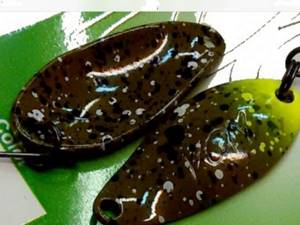
25mm. Noushka is perfectly suited to the conditions of the river. Length and weight are perfectly balanced, so Noa's game doesn't falter even against the grain. Most likely, this is why it is attractive to both predators and leucorrhoea, but the main object of fishing for it is again the chub. Lobasty will not refuse to feast on this spinner. It most likely resembles a stupid insect that has fallen into the water, floundering in the stream from side to side, which provokes an attack from a white predator.
Search for perch
Perch is voracious and will most likely be found where there is an abundant food supply. Shallow water is an ideal place to start fishing, as whitebait lives there.
Next, you should look for promising points located near natural shelters: the edges of reeds, thickets of water lilies and snags sticking out of the water. There should definitely be perch in such places, but they are not always active.
Micro-oscillators “collect” an active predator at high speed, so you shouldn’t linger at one point. When biting actively, spoons have a huge advantage over jigs; they reach fish much faster and do not require replacement.
Micro-oscillators are a separate class of baits that require constant study of new material and application of theory in practice . You could even say that this is a separate world of lures, which also has its own specialization for certain fishing conditions and fish, certain shapes, colors and nuances in wiring. And to master the technique of fishing with micro-oscillators, you need to make a lot of effort, but this is a very gambling activity!
JESPA RINGO MIDI

24mm. To say that I love fishing with this spoon is an understatement. The largest chubs were caught with it. Moreover, the chub began to show interest in it from early spring, from mid-March, when the chub had not yet left its wintering pits. In these conditions, I used bottom fishing, when you throw the spoon diagonally upstream, raise the rod at an angle of 120 degrees and reel in the slack line until the spoon touches the bottom. Then we lower the tip of the spinning rod to the surface of the water and begin to carry out delicate retrieving, trying to ensure that the spoon does not rise above ten centimeters from the bottom. It is difficult to explain how to achieve this - everything will come with experience, the road will be mastered by those who walk. But such wiring is very effective when the fish feeds in the bottom layer. But Ringo also needs to be fished in the middle and surface layers. In the summer, when the fish are near the surface or in the thickets of grass, this spinner casts perfectly on pauses, and combinations of all kinds of movements are the key to understanding this wonderful bait.
Spreaders and castmasters for perch
Having determined a kind of top in spinners, you can move on to another category of lures for perch. Oscillating spoons come in many different shapes and colors. But as a rule, most experienced fishermen use various micro-oscillators, which are often used to catch trout. Micro-oscillators for catching perch in the current are not suitable because their weight is too small (up to 5-6 grams); the current will immediately lift them into the upper layers of the water, and as we already know, the perch stays mainly in the bottom layer.
The main use of oscillators is in shallow waters where it is not possible to carry out a turntable due to the shallow depth. For example, let’s take a coastal zone where the bottom is covered with vegetation and the depth does not exceed half a meter. This is where light spinners will help out.
These lures are perfect for ultralight fishing. Due to the single hook, there will be no problems with painless removal of the tee for the perch, like with a spinner. You need to be very careful with such bright colors. With an almost complete absence of bite, they are the ones who can provoke the perch to bite.
Such a spoon will bring good catches in places with a grassy bottom on sunny summer days. The spinner will not stand out too much from the rest of the background, but at the same time it will create movements that can attract a striped predator.
A heavier spoon with a slightly narrowed shape will allow it to be carried out at a depth of about a meter, which is excellent for fishing in thickets of reeds and water lilies.
And meps managed to make a mark in the spinners, thanks to its mepps syclops spinner, which is excellent at catching not only pike, but also copes with catching large perch. If desired, you can remove the red tip from the hook. It has been repeatedly noticed that, for example, in the Volga delta, many local residents remove such bright tails from baits, believing that they scare away fish, and removing them will increase the number of bites.
Don't forget about castmasters. Due to their large weight, they will calmly sink to the bottom and provoke the perch to bite. Castmasters began to multiply over time in terms of their forms. For example, the first photo shows a castmaster with more rounded edges. But most fishermen prefer to use a standard form with various stickers.
ROB STALK
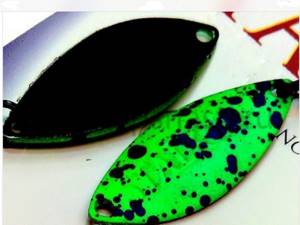
I learned about the Stalk spinner from friends. They were chub fishing, where they discovered its potential. As a result, they told me that that day the chub ate this spoon with terrible force, there were two spoons in the arsenal and both were lost on chubs over kg, and the tackle was not designed for such fish. After this information, I bought myself a couple of spinners without hesitation. In the end, I didn’t lose a bit; on one of my rafting fishing trips they came in handy. But not for long, maybe it was a big coincidence or I just happened upon a great opportunity, but I lost my first lure on a heavy asp on the first cast.
Here is how it was. While rafting along a riffle, I cast into the very stream and got a powerful bite, the rod bent to the butt, the clutch began to sing, after fighting for about five minutes with this powerful fish and bringing it to the boat, I managed to see that the fish was really big and it already seemed that it almost in my hands, as an asp, seeing me, gives battle, showing all his stern disposition. I couldn’t do anything with it, there were long algae at the bottom of the river that were wrapped around the fishing line, and the depth in this place was 2.5-3 meters, so I tore off the spinner without holding the trophy in my hands.
JESPA T-SURFACE
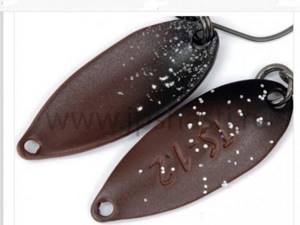
24mm. Another masterpiece vibrator from Jespa. One of my favorite fishing methods is fishing in small forest shallow rivers, moving through waders. On one of these fishing trips, I stand knee-deep in water on a riffle, I use it as a bait, I cast into the stream above, and start retrieving, but I quickly reel in the slack line, the current does the rest for me. The water in that river is very clean, so I can see everything, and polar explorers can help. The flock means I’m retrieving, enjoying the beautiful view and the singing of birds, the chirping of various insects and the murmur of water, when suddenly a chub quickly flies out from under a snag and rushes after the bait, followed by a bite (yes, so neat that I didn’t feel anything, but for a split second the bait disappeared into the mouth of a white predator), here, by the way, you can think about how many such bites there are, so neat that even the line doesn’t sway.
I make a second cast, carry out a similar retrieve and this time I get a powerful bite and the fish flutters pleasantly, this time everything is according to the classics (powerful bite, decent resistance), a trophy in my hands, a photo for memory and the fish is free, back into the water.
All that remains to be said about this lure is that it is perhaps one of the most versatile lures out of a couple of hundred micro-spinners that I have ever had the pleasure of catching fish with. She equally beautifully catches trout on the platform, as well as diverse fish in all kinds of wild reservoirs. During the season, I lost and bought this particular spinner several times and again I was consistently caught with it. This is the main advantage of Japanese micro-spinning spoons, that if you lose a catchable spoon, you can restore it without any problems, and the parameters of the restored spinner will be completely identical to the lost one. The spinner is not capricious in terms of wiring and will forgive many incorrect actions of a beginner fishing with micro-oscillators.
OFFICE EUCALYPTUS TRIGGER
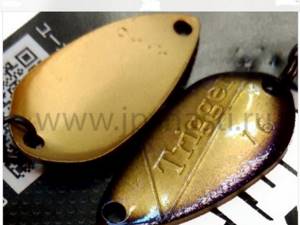
23mm. For its light weight, this spinner has a fairly wide body, which allows the use of the slowest retrieves, while the oscillatory properties will not be lost. Although this model was created for trout, practice has shown that it was in this color that the micro-spreader was to the taste of the roach; out of 9 roaches caught last season on the spinner, three were caught on it. I don’t know why it is so attractive to peaceful fish, but with enviable regularity I have seen how the roach, accompanying the fisherman in the flesh to my feet, periodically bales on it - a funny sight. In addition to roach, rudd is also consistently caught with it. Let's just say that this spoon is not the best for chub hunting, but if you want to diversify your trophies with the types of fish described above, then the trigger will be suitable for these purposes.
SV-Fishing Air
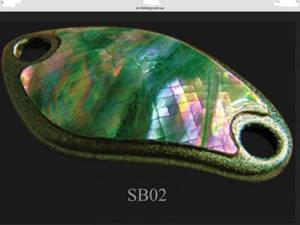
18mm. The Ukrainian young company SV-Fishing Lures, led by Taras Rychka, created an awesome micro-oscillator Air. I have already reviewed this spinner; a couple of years ago I was given a dozen and a half spinners for testing.
It was late autumn, November. But the thirst to try new things took its toll. Having grabbed some bait, I went to the pond, where I discovered this baby. That day, all the chub were caught with it, although the size of the trophies was not large, but the fish were caught with enviable consistency. Then there was a long winter, during which time at the exhibition I bought myself another one of the same spinner, slightly in a different color (as in the picture), the series is called Shelby, the coating is made of natural materials, or rather from mother-of-pearl shells. I don’t know how effective this coating is, but the one I bought worked reliably. The first spring chub was caught with it. But unfortunately, spinners sometimes, like any other consumable, tend to get lost. I lost one on a very large chub, the fly could not withstand the bite of a powerful fish and as a result burst. The second one, as if not on the shore, but it was never possible to save it, on a platform when fishing for trout, being carried away by fishing, he made a careless cast and hung it on an oak branch above the water, and could not get it, I had to tear it off. That day, by the way, she did a good job of mowing trout, so it was very annoying to leave the baby behind.
Selection of gear for catching perch with micro-oscillators
To catch perch with ultralight, the first thing you need to do is choose a spinning rod.
The length of the spinning rod depends on the fishing conditions. The average height ranges from 2 to 2.2 meters. The light rod test is equal to the weight of the bait that will be used for fishing. The rod must have an additional margin of strength, which makes it possible to compete with a trophy specimen. A spinning rod needs a medium action, since the spinner produces characteristic vibrations, which are poorly tolerated by the softer tip of the rod.
Ultralight spinning rod for ultralight, more details about the equipment.
When fishing for perch, a cord is most often used, and a meter and a half of fluorocarbon fishing line is tied as a leash. It has no memory and is refracted in the water in such a way that the fish do not notice it. The diameter of the cord ranges from 0.06 to 0.1 mm. Fluorocarbon should be an order of magnitude thicker, since it does not have the same strength as braided thread.
You cannot skimp on the reel, since it is responsible for feeding the cord, laying it out and not twisting it. The budget option will tangle the thread, and half of the fishing will be spent on unraveling it. The weight of the coil should be minimal so that the kit feels complete. Read more about coil parameters for ultralight.
SV-Fishing Koketka
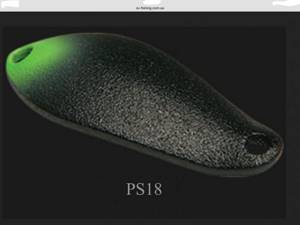
30mm. I rarely catch spoons larger than 2.5 grams, following the rule that the smaller the bait, the greater the species composition that will encroach on the crumbs. There are exceptional cases when it is necessary to get larger (competitions) in order to reach a fish that is frightened and has moved away from the shore, or purposeful fishing exclusively for a predator. I think that a yoke weighing 3g is perfect for these purposes. The lure has the shape of a spoon, a kind of reduced atom, which in turn is recognized as a pike classic among the fishing community.
It happened in the spring, on one of the forest streams in the Lipetsk region, where Koketka showed herself in all her glory. The color was just like in the picture, I don’t know why the pike liked it that day, but there were a lot of bites on it until the spoon was bitten off. There were no trophies that day, all the pike were small, from 500 to 1.5 kg, but fishing with light tackle completely compensated for this deficiency.
How to make a homemade spinner
Surely a fisherman has ever had the desire to make lures for perch with his own hands. And this is a rather natural desire, because it is not so easy to please a capricious fisherman. Either the color is wrong for him, or the weight is too high, and so on.
If you look closely at the turntables, you will notice that their base is a wire on which all other components are attached. You can calmly either unwind it or simply have a snack. And the pinwheel will disintegrate into all its components. And now a person will have great opportunities to create a new bait. You can experiment with different weights, adding additional weights, increasing the number of beads and changing the shape of the petal. You can try using feathered hooks. As a result, we can say that imagination will work here and perhaps that homemade perch spoon will turn out to be the most catchy.
Read more about making a homemade spinner at home.
If everything is more or less clear with turntables, then creating oscillators will be a more labor-intensive process, since you need to choose the optimal shape and bends so that the product gets its play. Some enthusiasts made spinners from ordinary spoons.
MUKAI FIRE BALL
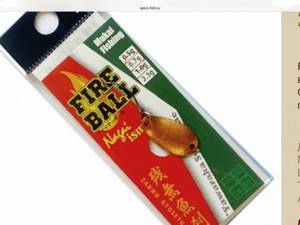
Quite a rare spinner from a famous Japanese manufacturer. My first spinner is less than 1 gr. A very interesting upside-down spoon, the hook is located in the narrow part. As a result, the spinner moves with its wide part forward, reminiscent of a frog's tadpole in its play and shape. The best time to use this crumb is at the beginning of summer, during the massive filling of reservoirs with tadpoles. The fish will not refuse the opportunity to feast on amphibians that have strayed from the school. Another plus of fir-bail is that it flows amazingly during pauses. It can be used with vertical trolling in small windows among thickets of grass, where fish like to hide and feast on passing bugs.
